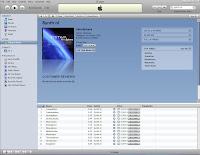
Last week I finally started mounting the acoustics material that I had lying around for a long time. Here you can see a picture of one of the bass traps. As I told before I ordered this special material from a German company called AIX foam. The blocks came in lengths of two meters each and since the total height of my studio is 2,40 meters I had to think of some kind of way to mount it. I didn't want to glue everything to the wall either since maybe this won't even be sufficient and maybe I need to remove them again. We need to do some measurements first. The solution was to mount a plank at about 2 meters from the ceiling. Put two blocks on top of each other. And then I had to cut another block into smaller pieces and put that under the plank. This way I can also easily remove the lower part and still be able the reach the cable guiding system that is running below it. It worked very well in both corners behind me. So now that this is done I can continu to put stuff in front of this corners and start cabling there.

Another thing I did was mounting three acoustic panels on the walls left and right of me. Just on my listening position. This is to improve the stereo image on my main monitors. It helps to keep reflections on that place. You don't want to hear sounds from your left monitor bouncing of your right wall. I didn't want to glue these panels to the wall either, so I started by drilling some holes in the wall, putting screws in there, hanging a wooden plate on the screws (just like a painting) and the glue the acoustic panels on the plates. This worked out very well. I used special glue by the way from Auralex. It is made to fasten quickly and not damage the foam. A lot of clue will probably eat up the material due to chemical reactions. I can really recommend this glue since the panels were already hanging firmly after about 30 seconds.

On the wall in front of me I had another challenge. In both corners is a cable guiding system that is 4 by 4 cm's wide. So I had to cut out a strip of 4 by 4 cm's of the corner traps. Otherwise they wouldn't fit tightly in the corners. I was a bit afraid to cut in the material at first since it is quite expensive to screw up. But well it doesn't happen on it's own. I ended up using a very sharp hobby knive (the type with multiple blades you can break off). You can normally push the blade out so that you have one long blade. Making a sawing motion I could cut through the foam quite easily and even quite precise. So this was not as hard as I had imagined. Only cutting a 2 meter block into 3 pieces is a bit harder since the blocks are quite big and you can only cut so deep. But I also managed this in the end with the same simple knife. Here you see some rest material.

I still have lots of panels left, so I can go around and fix some more problems with those. But first I will ask my friend Hanz to come over and do some measurements again to see what the effect was of this job. I hear improvement already, which is nice of course, but we need to see it in the graphs to know how much effect it had.
I will keep you informed about this process of course. Another effect these panels had in the room is because of the brighter color I have a bit more light now. There is just more light reflecting now. I will have to buy I dimmer now I guess :)
 Since MySpace is my main source of marketing I decided to do something extra on there. I'm featering the song 'Lift' from my first album 'AeroDynamics' on my player there to promote my first album a bit more. So if you don't know that song yet go and have a listen on my MySpace page. You can't hear it anywhere else. You can find my MySpace page here: http://www.myspace.com/synthnl.
Since MySpace is my main source of marketing I decided to do something extra on there. I'm featering the song 'Lift' from my first album 'AeroDynamics' on my player there to promote my first album a bit more. So if you don't know that song yet go and have a listen on my MySpace page. You can't hear it anywhere else. You can find my MySpace page here: http://www.myspace.com/synthnl.




























































